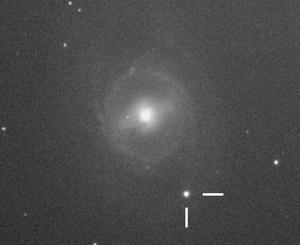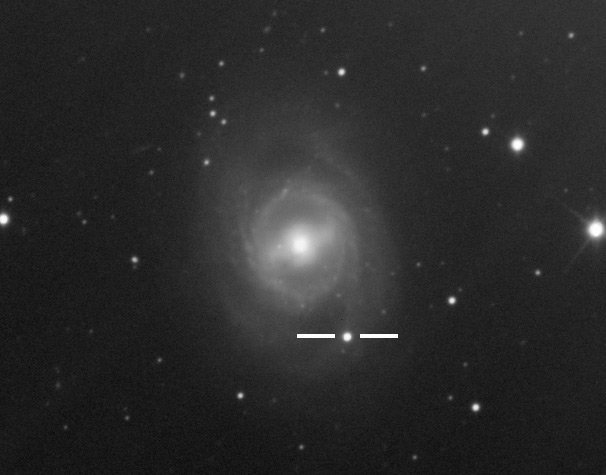Create a free profile to get unlimited access to exclusive videos, sweepstakes, and more!
Supernova 2012aw: the pictures!

Last night, I wrote about a possible new supernova in the galaxy M95, a nearby spiral. It has since been confirmed, and is called SN 2012aw. Given that M95 is about 37 or so million light years away -- close on a galactic scale -- that means this exploding star will be easy to see even with smaller telescopes. I asked folks if they could send me images, and send them they have!
Here's one from Greek amateur astronomer Anthony Ayiomamitis, using a 30.5 cm (roughly 12") telescope -- and it's hot off the 'scope; as I write this he took this image just a couple of hours ago:
How about that? The supernova is marked. Not only that, it's sitting right on a spiral arm, and as soon as I saw that I knew it was a Type II: when a massive star explodes at the end of its life. Those kinds of stars are born in spiral arms and don't live long enough to wander out of them -- that can take many tens of millions of years, and these massive, hot stars live only a few million years at most. And sure enough, spectra taken have revealed the presence of hydrogen in the explosion, which only happens in these kinds of exploding stars*.
 Another image was taken by George Carey which looks very much like Anthony's (they both have the same sized telescopes, though very different in design). This makes me think we'll be seeing a lot more images of this soon, including from some big, professional observatories.
Another image was taken by George Carey which looks very much like Anthony's (they both have the same sized telescopes, though very different in design). This makes me think we'll be seeing a lot more images of this soon, including from some big, professional observatories.
I have to point out this sequence taken by Parijat Singh, which he made into an animation. The first half of the sequence was taken on March 15, and the second on March 16. Keep your eyes just above and to the right of the galaxy center... [You may need to refresh this page to see the embedded video.]
Pop! [The various streaks you see in some frames are, I believe, satellites passing through the field of view.]
Images like these are critical; they put an upper limit on how bright the supernova was just before it exploded, which helps scientists figure out the physical processes that go in in the very early hours of a star exploding. That's hard to catch, so there aren't many observations of very young supernovae. Clearly though, with more amateur astronomers with better equipment patrolling the skies all the time, we'll be getting more shots like these.
The current brightness of the supernova is around 13.3, but I expect it'll get brighter in the coming days. Not bright enough to see naked eye, and you'll still probably need a 30cm telescope to see it without a digital camera, but that's still pretty cool. Stay tuned!
Images credits: Anthony Ayiomamitis; George Carey; Parijat Singh.
* UPDATE: I got a note from my friend and supernova expert Alex Filippenko. He points out that just seeing a supernova in a spiral arm doesn't guarantee that it was a massive star; the other major type of supernova (Type Ia) happens with very old stars, and these can by coincidence happen to be in a spiral arm when they go off. He's right (of course). He also notes that Type Ib and Ic supernovae are from massive stars; and perhaps I shouldn't have limited myself to this one being a Type II. The taxonomy of supernovae is a little confusing, and maybe someday that'll be the topic of a post here!















